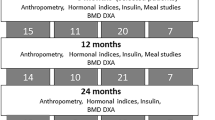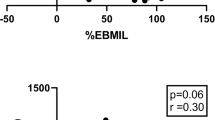Abstract
Background
The aim of this observational study was to determine, in a retrospective analysis, whether growth hormone (GH) and insulin-like growth factor-1 (IGF-1) at baseline or changes in the GH/IGF-1 axis after laparoscopic adjustable gastric banding (LAGB) is associated with weight loss and body composition changes in severely obese nondiabetic patients.
Methods
Weight loss (expressed as percent excess weight loss [EWL%]), anthropometry, body composition by bioelectrical impedance analysis (BIA), serum IGF-1, and GH peak after GH-releasing hormone (GHRH) plus arginine (ARG) test were measured and expressed as standard deviation scores (SDS) of reference values in 104 women and 36 men, age (mean ± SD) 34 ± 11 and 30.2 ± 11 years, and BMI 44 ± 5.7 and 39 ± 3.2, respectively, before and 6 months after LAGB.
Results
After LAGB, 25% of women and 22.5% of men had GH deficiency, while 30.8% of women and 33.3% of men had IGF-1 deficiency or insufficiency. The median EWL was 36.8% in women and 40.0% in men. In both genders, percent decrease of waist circumference, EWL, and fat mass (FM) and percent increase of fat-free mass (FFM) was greater in patients with normal GH secretion and IGF-1 levels. The GH peak after GHRH + ARG, IGF-1 levels, and IGF-1 SDS were inversely correlated with EWL% (r = −0.50, r = −0.53, and r = −0.42, respectively; p < 0.0001) and percent FM (r = −0.41, r = −0.36, and r = −0.35, respectively; p < 0.0001). In stepwise linear regression analysis, the GH peak after GHRH + ARG was the major determinant of EWL% (p < 0.0001) and FM (p = 0.001).
Conclusions
The efficacy of LAGB was greater in the patients with a normal GH response to GHRH + ARG and with normal IGF-1 levels. The percent of FM, FFM, and EWL were significantly correlated with the GH response to GHRH + ARG and with IGF-1 levels.

Similar content being viewed by others
References
Veldhuis JD, Iranmanesh A, Ho KK, et al. Dual defects in pulsatile growth hormone secretion and clearance subserve the hyposomatotropism of obesity in man. J Clin Endocrinol Metab. 1991;72:51–9.
Johannsson G, Bengtsson BA. Growth hormone and the metabolic syndrome. J Endocrinol Invest. 1999;22(5 Suppl):41–6.
Giustina A, Veldhuis JD. Pathophysiology of the neuroregulation of growth hormones secretion in experimental animals and the human. Endocr Rev. 1998;19:717–97.
Scacchi M, Pincelli AI, Cavagnini F. Growth hormone in obesity. Int J Obes Relat Metab Disord. 1999;23:262–71.
Maccario M, Tassone F, Grottoli S, et al. Neuroendocrine and metabolic determinants of the adaptation of GH/IGF-1 axis to obesity. Ann Endocrinol (Paris). 2002;63:140–4.
Savastano S, Di Somma C, Mentone A, et al. Growth hormone insufficiency in obese patients. J Endocrinol Invest. 2006;29:536–44.
de Boer H, Blok GJ, Van der Veen EA. Clinical aspects of growth hormone deficiency in adults. Endocr Rev. 1995;16:63–86.
Carroll PV, Christ ER, Bengtsson BA. Growth hormone deficiency in adulthood and the effects of growth hormone replacement: a review. Growth Hormone Research Society Scientific Committee. J Clin Endocrinol Metab. 1998;83:382–95.
Colao A, Cerbone G, Pivonello R, et al. The growth hormone (GH) response to arginine plus GH releasing hormone test is correlated to the severity of lipid profile abnormalities in adult patients with GH deficiency. J Clin Endocrinol Metab. 1999;84:1277–82.
Colao A, Di Somma C, Cuocolo A, et al. The severity of growth hormone deficiency correlates with the severity of cardiac impairment in 100 adult patients with hypopituitarism: an observational, case-control study. J Clin Endocrinol Metab. 2004;89:5998–6004.
Gola M, Bonadonna S, Doga M, et al. Clinical review: growth hormone and cardiovascular risk factors. J Endocrinol Invest. 2005;90:1864–70.
Abs R, Feldt-Rasmussen U, Mattsson AF, et al. Determinants of cardiovascular risk in 2589 hypopituitary GH-deficient adults—a KIMS database analysis. Eur J Endocrinol. 2006;155:79–90.
Pasquali R, Vicennati V, Gambineri A, et al. Hormones and pathophysiology of obesity. Eat Weight Disord. 2001;6(3 Suppl):9–20.
Franco C, Bengtsson BA, Johannsson G. Visceral obesity and the role of the somatotropic axis in the development of metabolic complications. Growth Horm IGF Res. 2001;11(Suppl A):S97–102.
Biller BM, Samuels MH, Zagar A, et al. Sensitivity and specificity of six tests for the diagnosis of adult GH deficiency. J Clin Endocrinol Metab. 2002;87:2067–79.
Qu X, Gonzalo TGI, Al Sayed MY, et al. Influence of body mass index and gender on GH responses to GHRH plus arginine and insulin tolerance test. J Clin Endocrinol Metab. 2005;90:1563–9.
Corneli G, Di Somma C, Baldelli R, et al. The cut-off limits of the GH response to GH-releasing hormone-arginine test related to body mass index. Eur J Endocrinol. 2005;153:257–64.
Rasmussen MH, Hviderbg A, Juul A. Massive weight loss restores 24-hour growth hormone release profiles and serum insulin-like growth factor-I levels in obese patients. J Clin Endocrinol Metab. 1995;80:1407–15.
Edén Engström B, Burman P, Holdstock C, et al. Effects of gastric bypass on the GH/IGF-1 axis in severe obesity—and a comparison with GH deficiency. Eur J Endocrinol. 2006;154:53–9.
Savastano S, Di Somma C, Belfiore A, et al. Growth hormone status in obese patients and correlation with body composition. J Endocrinol Invest. 2006;29:536–43.
Di Somma C, Angrisani L, Rota F, et al. Growth hormone and insulin-like growth factor-i deficiency are associated with reduced loss of fat mass after laparoscopic-adjustable silicone gastric banding. Clin Endocrinol (Oxf). 2008;69:393–9.
Frystyk J. Free insulin-like growth factors: measurements and relationships to growth hormone secretion and glucose homeostasis. Growth Horm IGF Res. 2004;14:337–75.
Maccario M, Ramunni J, Oleandri SE, et al. Relationships between IGF-1 and age, gender, body mass, fat distribution, metabolic and hormonal variables in obese patients. Int J Obes Relat Metab Disord. 1999;23:612–8.
Anonymous. NIH Conference. Gastrointestinal surgery for severe obesity. Consensus Development Conference Panel 1991. Ann Intern Med. 1991;115:956–61.
Lamberts SW, de Herder WW, van der Lely AJ. Pituitary insufficiency. Lancet. 1998;352:127–34.
Kotler DP, Burastero S, Wang J, et al. Prediction of body cell mass, fat-free mass, and total body water with bioelectrical impedance analysis: effect of race, sex, and disease. Am J Clin Nutr. 1996;64:489S–97S.
Piccoli A, Brunani A, Savia G, et al. Discriminating between body fat and fluid changes in the obese adult using bioimpedance vector analysis. Int J Obes. 1998;22:97–104.
Ghigo E, Aimaretti G, Gianotti L, et al. New approach to the diagnosis of growth hormone deficiency in adults. Eur J Endocrinol. 1996;134:352–6.
Colao A, Di Somma C, Cascella T, et al. Relationships between serum IGF1 levels, blood pressure, and glucose tolerance: an observational, exploratory study in 404 subjects. Eur J Endocrinol. 2008;159:1–10.
Ho KK, GH Deficiency Consensus Workshop Participants. Consensus guidelines for the diagnosis and treatment of adults with GH deficiency II: a statement of the GH Research Society in association with the European Society for Pediatric Endocrinology, Lawson Wilkins Society, European Society of Endocrinology, Japan Endocrine Society, and Endocrine Society of Australia. Eur J Endocrinol. 2007;157:695–700.
Hu FB, Rimm E, Smith-Warner SA, et al. Reproducibility and validity of dietary patterns assessed with a food-frequency questionnaire. Am J Clin Nutr. 1999;69:243–9.
Kuzmak LI. A review of seven years' experience with silicone gastric banding. Obes Surg. 1991;1:403–8.
Angrisani L, Lorenzo M, Esposito G, et al. Laparoscopic adjustable silicone gastric banding: preliminary results of Naples experience. Obes Surg. 1997;7:19–21.
Busetto L, Pisent C, Segato G, et al. The influence of a new timing strategy of band adjustment on the vomiting frequency and the food consumption of obese women operated with laparoscopic adjustable silicone gastric banding (LAP-BAND®). Obes Surg. 1997;7:505–12.
Oi Y, Okuda T, Koishi H, et al. Effects of low energy diets on protein metabolism studies with [15N]glycine in obese patients. J Nutr Sci Vitaminol. 1987;33:227–37.
Micic DD, Cubrilo KM. Obesity and male reproduction function. Obes Metabol. 2006;2:13–27.
della Valle E, Stranges S, Trevisan M, et al. Self-rated measures of physical activity and cardiovascular risk in a sample of Southern Italian male workers: the Olivetti heart study. Nutr Metab Cardiovasc Dis. 2004;14:143–9.
Adams TD, Heath EM, LaMonte MJ, et al. The relationship between body mass index and per cent body fat in the severely obese. Diabetes Obes Metab. 2007;9:498–505.
De Marinis L, Bianchi A, Mancini A, et al. Growth hormone secretion and leptin in morbid obesity before and after biliopancreatic diversion: relationships with insulin and body composition. J Clin Endocrinol Metab. 2004;89:74–80.
Lukanova A, Soderberg S, Stattin P, et al. Nonlinear relationship of insulin-like growth factor (IGF)-I and IGF-1/IGF-binding protein-3 ratio with indices of adiposity and plasma insulin concentrations (Sweden). Cancer Causes Control. 2002;13:509–16.
Mauras N, Haymond MW. Are the metabolic effects of GH and IGF-1 separable? Growth Horm IGF Res. 2005;15:19–27.
Iranmanesh A, Lizarralde G, Veldhuis JD. Age and relative adiposity are specific negative determinants of the frequency and amplitude of growth hormone (GH) secretory bursts and the half-life of endogenous GH in healthy men. J Clin Endocrinol Metab. 1991;73:1081–8.
Veldhuis JD. Gender differences in secretory activity of the human somatotropic (growth hormone) axis. Eur J Endocrinol. 1996;134:287–95.
van den Berg G, Veldhuis JD, Frölich M, et al. An amplitude-specific divergence in the pulsatile mode of growth hormone (GH) secretion underlies the gender difference in mean GH concentrations in men and premenopausal women. J Clin Endocrinol Metab. 1996;81:2460–7.
Colao A, Di Somma C, Pivonello R. Bone loss is correlated to the severity of growth hormone deficiency in adult patients with hypopituitarism. J Clin Endocrinol Metab. 1999;84:1919–24.
Acknowledgments
This study has been partially granted by the Ministry of University Research of Italy, PRIN, with the number 2007N4C5TY_005. We thank Dr. Emanuele Nicolai (SDN Foundation IRCCS, Naples – Italy) for kindly providing DXA analyses.
Author information
Authors and Affiliations
Corresponding author
Rights and permissions
About this article
Cite this article
Savastano, S., Angrisani, L., Di Somma, C. et al. Relationship Between Growth Hormone/Insulin-Like Growth Factor-1 Axis Integrity and Voluntary Weight Loss After Gastric Banding Surgery for Severe Obesity. OBES SURG 20, 211–220 (2010). https://doi.org/10.1007/s11695-009-9926-3
Received:
Accepted:
Published:
Issue Date:
DOI: https://doi.org/10.1007/s11695-009-9926-3




